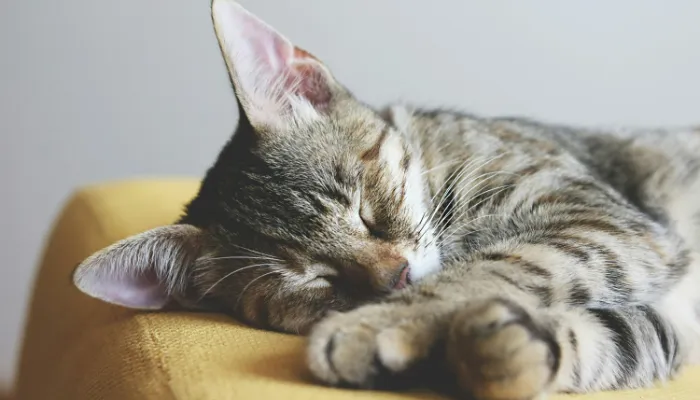Cats are famous for their enigmatic and self-reliant traits often leading their owners to ponder what’s brewing in their furball’s mind. Cats, unlike dogs who are more vocal, provide some form of bodily movement, sounds, and actions.
If and when you ever asked yourself, How do cats say “yes”? then do not be worried! Even though they do not nod or verbally concoct an agreement like humans, their means of showing approval is quite unique. Although you can consider using a cat translator, there are some signs of your cat saying yes.
In this guide, we will tell you how a cat shows approval ranging from kneading, purring, body language, and even vocalizations. Understanding these signals will not only strengthen the bond you share with your feline companion but allow you to meet their needs more efficiently.

Understanding Cat’s Way of Approval
Cats vocalize, move around their bodies, and perform certain actions to express ‘yes’, which signals agreement and happiness. Cats say, “What about some saucers with milk, and butter on the side?” in the form of gentle head rub, slow blinks or soft meows.
Signs That Your Cat Is Saying Yes
The following behaviors may suggest your cat’s approval:
- Purring: The most common sign of a happy and relaxed cat is to signal enjoyment by purring.
- Slow blinking: Kitties blink slowly at things they love. If you see your kitty doing it, then know that your cat is showing trust and friendliness toward you.
- Kneading: Cats fold their paws in motion like they are kneading a dough when they feel relaxed and secure.
- Head butting: Head rubbing or head banging is a non-verbal way of expressing fondness or appreciation towards someone.
- Gentle meowing: A soft, agreeable meow can signify consent or the need for attention. This cuts across different emotions.
Trying to understand these signs can help one to better interact with your cat and meet its needs.
The Role of Sounds in Feline Agreement
Cats speak different languages, figuratively speaking. They have their form of communication that can be songs, jokes, or motivational speeches conveyed in purrs, meow, and even chirp.
Common Cat Sounds and Their Meanings
| Cat Sound | Meaning |
|---|---|
| Purring | Contentment, approval, or relaxation. |
| Soft Meows | Agreement, attention-seeking, or happiness. |
| Chirping | Excitement, greeting, or acknowledgment. |
| Trilling | A friendly sound often used to express approval. |
If you’ve asked yourself How do cats say “yes”? Carefully observe their active response at that particular moment. If a cat meows while being cuddled, they are softening yes for you.
When Cats Use Their Voice To Say “Yes”
- If a cat lets out excited meows as one vigorously shakes a treat bag, it’s their way of saying yes.
- When they hiss, there’s a good chance that they might still be approving of your attempt to get their attention.
- If a kitten greets you with a trill, it means they like you.
There is a multitude of ways in which a cat can communicate their feelings towards you, and the sound they produce is probably the most effective indicator.
Body Language: The Silent “Yes”
Cats do not need to make noise in order to express themselves; they can easily employ a different technique which is body language. Learning these physical gestures and behaviors will help you interpret their responses correctly.
Gestures of Cats that Mean “Yes”
- Slow Blinking: When a cat gives you a slow blink, it means they are comfortable and trust you.
- Relaxed Ears: A more relaxed position of the ears is neutral, and it signals that they agree with their situation and feels calm.
- Tail Held High: A happy, confident cat will usually display a raised tail.
- Rubbing Against You: This is another clear signal of love or marking you as part of their territory.
- Rolling Over: It means the cat feels relaxed and safe with you.
What to Do When Your Cat Shows These Signs
- It is known that a cat will trust you if you both slow blink together.
- If they rub against you, show your hand to them and give them a gentle scratch or stroke.
- A cat in a good mood will walk with their tail raised high, so give them some toys or join them for a game.
Fostering a deeper relationship with your cat is possible by noticing and reacting to the cues that they give you.
How Cats Say “Yes” Through Physical Actions?
Besides vocal reactions and body movements, there are several other ways how do cats say “yes”. The actions might not be clear as a meow or a lift of a paw, but once you notice them, it is clear that they have always been saying “yes.”
Actions That Suggests Agreement
- Following You Around
- If your feline companion roams around the house and follows you, it means “Yes, I want to be with you.”
- Jumping Into Your Lap
- Cats tend to display trust and gratitude by jumping and cuddling on your lap.
- Accepting Petting
- If your cat moves their face towards your fingers and leans into your affection, they are agreeing to your show of love.
- Sleeping Near You
- Since cats tend to be sensitive during sleep, finding solace beside you means they trust you greatly.
Once you understand these actions, you can properly adjust to your cat’s requests and reactions.
Tips to Encourage Positive Communication With Your Cat
Now that you understand how do cats say “yes”, you can utilize this information in a manner which helps develop a stronger emotional bond with your cat.
Here are some ideas to foster constructive interactions:
Methods of Improving the Exchange of Information and Ideas
- Notice their actions – Listen to their tone of voice and watch their movements.
- Act on their signals – If they perform a slow blink, blink back at them.
- Protect their personal space – Do not impose direct contact on them; allow them to approach when they are ready.
- Participate in fun activities – Playing together deepens your bond and lifts their spirits.
- Give praise and rewards for displaying good behaviors – When they show any form of approval, use pets and treats to reward them.
By actively understanding how your cat prefers to “speak,” you are guaranteed to build a more trusting and loving relationship.
Conclusion
While cats do not agree or say ‘yes’ in ways that humans do, they have other channels of communication that portray agreement and happiness. Through aggressive purring, slow blinking, rubbing their face across your body, and stalking you around the house are all working to send signals to you.
The next time you find yourself pondering, how do cats say “yes”? observe what sounds they make, how they move, and what they do. These behaviors can work wonders in establishing a closer relationship with your pet.
So, be on the lookout for these quiet nods of agreement, which may be in the form of a barely audible meow, a high held tail, or a gentle head nudge.
Pay special attention to your cat as she might be saying “yes” to you more or rather to you more than you think!
